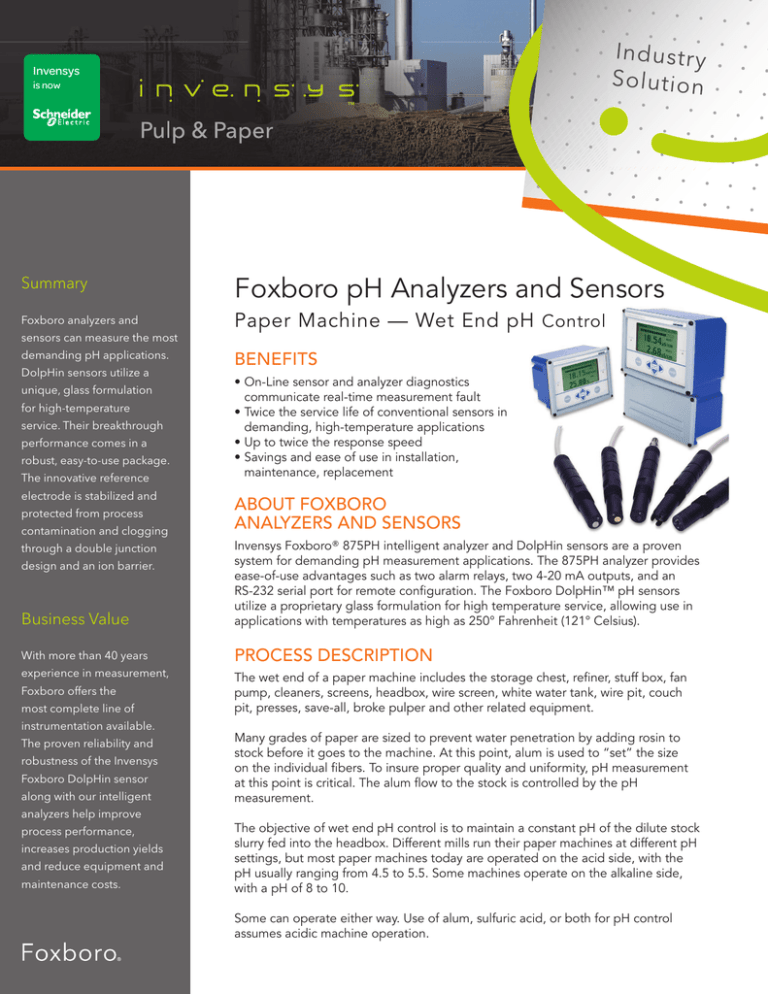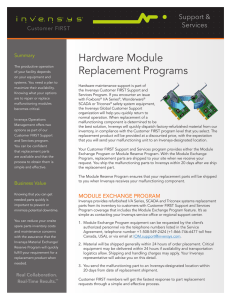
Invensys
is now
Summary
Foxboro pH Analyzers and Sensors
Foxboro analyzers and
Paper Machine — Wet End pH Control
sensors can measure the most
demanding pH applications.
DolpHin sensors utilize a
unique, glass formulation
for high-temperature
service. Their breakthrough
performance comes in a
robust, easy-to-use package.
The innovative reference
electrode is stabilized and
protected from process
contamination and clogging
BENEFITS
••On-Line sensor and analyzer diagnostics
communicate real-time measurement fault
••Twice the service life of conventional sensors in
demanding, high-temperature applications
••Up to twice the response speed
••Savings and ease of use in installation,
maintenance, replacement
ABOUT FOXBORO
ANALYZERS AND SENSORS
Business Value
Invensys Foxboro® 875PH intelligent analyzer and DolpHin sensors are a proven
system for demanding pH measurement applications. The 875PH analyzer provides
ease-of-use advantages such as two alarm relays, two 4-20 mA outputs, and an
RS-232 serial port for remote configuration. The Foxboro DolpHin™ pH sensors
utilize a proprietary glass formulation for high temperature service, allowing use in
applications with temperatures as high as 250° Fahrenheit (121° Celsius).
With more than 40 years
PROCESS DESCRIPTION
experience in measurement,
The wet end of a paper machine includes the storage chest, refiner, stuff box, fan
pump, cleaners, screens, headbox, wire screen, white water tank, wire pit, couch
pit, presses, save-all, broke pulper and other related equipment.
through a double junction
design and an ion barrier.
Foxboro offers the
most complete line of
instrumentation available.
The proven reliability and
robustness of the Invensys
Foxboro DolpHin sensor
along with our intelligent
Many grades of paper are sized to prevent water penetration by adding rosin to
stock before it goes to the machine. At this point, alum is used to “set” the size
on the individual fibers. To insure proper quality and uniformity, pH measurement
at this point is critical. The alum flow to the stock is controlled by the pH
measurement.
analyzers help improve
process performance,
increases production yields
and reduce equipment and
maintenance costs.
The objective of wet end pH control is to maintain a constant pH of the dilute stock
slurry fed into the headbox. Different mills run their paper machines at different pH
settings, but most paper machines today are operated on the acid side, with the
pH usually ranging from 4.5 to 5.5. Some machines operate on the alkaline side,
with a pH of 8 to 10.
Some can operate either way. Use of alum, sulfuric acid, or both for pH control
assumes acidic machine operation.
APPLICATION CHALLENGE
This area of the paper process is very hard on electrochemical sensors. The process is a thick consistency
stock, and very rough on electrodes. The process temperature can run from 50° C (122° F) to over 90° C
(194° F). High temperature shortens the useful life of the pH electrode. Often the machine is shut down
for a cleaning process called a boil-out. At this time, a wash of heated water and caustic at about 13%
to 18% is used to clean the buildup from the screen and pans. This will destroy the glass electrode after
a few cycles.
The demand for upgrading paper quality and uniformity has introduced tougher challenges to online
sensors. For example, in color control, the use of new pigments, dyes, fillers, and bonding agents has
changed the wet end process environment. What is good for the process, however, is not always good
for the sensors necessary for control.
The same pigments, dyes, and fillers that bond well to fibers also bond to sensor surfaces, creating the
need for diligent maintenance.
Installation of pH sensors is often difficult. The optimum point for the measurement is in the head box
circulation line. This proven location provides minimum dead time between the point of measurement
and the point of addition of alum or sulfuric acid, an important consideration in providing stable
control. However, this location tends to be difficult to access, so many users select the tray locations.
The tray location is convenient, and easy to achieve, but introduces a longer dead time between
measurement and point of chemical addition.
Hundreds of hours are spent each year cleaning pH sensors in this very aggressive process area.
Although pH is a difficult measurement to implement here, it is critical due to its effect on paper
quality and uniformity. This control also impacts the ability to process the paper from this operation
to ensuing ones.
THE FOXBORO SOLUTION
Invensys Foxboro’s DolpHin™ Series sensors and intelligent pH analyzers solve the challenges of
controlling pH in the wet end of a paper machine. The DolpHin flat ruggedized electrode lasts longer
in this abrasive service due to the thickness of the glass membrane, while the flat profile resists
accumulation of fibers. In applications running above 85° C, the DolpHin high temperature electrode
is the best choice because of its proven ability to last longer at high temperature, due to its unique
glass formulation. Though the DolpHin electrodes last longer in high temperature and abrasives, it is
advisable to remove the sensor and store it in a pot of water during the boil-out procedure. Removal
during boil-out has extended the probe life well over 100%.
The recommended location for pH measurement is the circulation line from the headbox. A second
location is the fan pump discharge line. A third location is the white water tray. Some users object
to the circulation line due to the difficulty of installation. However, there are numerous methods of
installation to lessen this burden, among them retractable accessories such as ball valve assemblies,
and universal bushing adaptors.
When a DolpHin pH sensor is used in conjunction with an intelligent pH analyzer, the system can let
the user know if the sensor is coated or broken. When used in a predictive maintenance mode, it can
extend the life of the electrodes, and save many man-hours of service time.
Though never an easy implementation, effective pH control in the wet end area is critical to achieve
highest quality and uniformity of today’s highly competitive paper products.
Invensys Operations Management • 5601 Granite Parkway III, #1000, Plano, TX 75024 • Tel: (469) 365-6400 • Fax: (469) 365-6401 • iom.invensys.com
Invensys, the Invensys logo, ArchestrA, Avantis, Eurotherm, Foxboro, IMServ, InFusion, SimSci-Esscor, Skelta, Triconex, and Wonderware are trademarks of Invensys plc, its subsidiaries or affiliates.
All other brands and product names may be the trademarks or service marks of their representative owners.
© 2012 Invensys Systems, Inc. All rights reserved. No part of the material protected by this copyright may be reproduced or utilized in any form or by any means, electronic or mechanical, including
photocopying, recording, broadcasting, or by any information storage and retrieval system, without permission in writing from Invensys Systems, Inc.
Rev. 04/15
PN FX-0208






